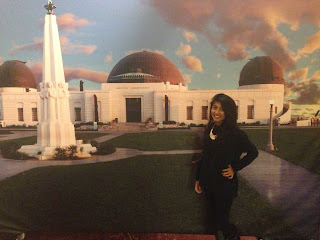Once again, I couldn't help but notice how much of science
is integrated into art during my visit to LACMA. There was an entire exhibit on
Art and Technology, and there were so many other beautiful paintings and
sculptures where I could distinctly see what a great influence science had in
creating and building them.
The turmoil of World War I affected artists across Europe
and the United States. A specific sect of artists called “Dadaists” created
works from everyday objects, discarded materials and street trash. The Red-Blue
Chair pictured below was created using such discarded materials. Blocks of wood
that were in the trash were picked up and this beautiful chair was created. The
works by the “Dadaists” pushed the conventions of how art was defined.
The painting pictured below really fascinated me. It is a
painting made by a young American artist during the Second World War. While
usually one would only notice its beauty and morbidity, I could not help but
think about how the artist perfectly captures the aspect of the human body and
anatomy.
The painting of the life-sized can of Spam also intrigued
me. It is interesting to see how the can is sailing like a comet in the sky. In
this way we see how the artist, Ruscha, adds an element of space into his artistic
work. It is also interesting to note that the element of space is added with
the intention of referencing the US-Russian Space Race.
Thomas Wilfred studied music and art in Europe. After moving
to America, he began constructing machines, which were based on the physical
characteristics of light- refraction, reflection and color. Wilfred was a
pioneer in the field of light art, art based on the manipulation of light. He
orchestrated silent performances of amorphous, moving forms that he hoped
viewers would experience as “the fundamental rhythmic flow of the universe.”
The Art and Technology exhibit was truly amazing to see.
Andy Warhol had three prototypes for artificial weather machines- one that
simulated snow; another, wind; and the third, rain. Warhol wanted to pair these
machines with holographic/3-D images and managed to successfully create the
Rain Machine- 3D prints of four plastic daisies on a bed of artificial grass
and in front of the prints, two layers of “rain” fell from metal water nozzles
that moved from side to side.
Another thing that caught my attention in this exhibit was
Robert Rauschenberg’s Mud Muse. Rauschenberg started working with a technology
company by had become very interested in art that actively engages its viewers.
He designed Mud Muse, which emulated the bubbling mud of Yellowstone National
Park’s geothermal “paint pots.” It is a sound activated piece that reacts to
both external sounds and an internal soundtrack of noises sampled from daily
life. The actual and recorded sounds are then translated into electrical “on-off”
signals relayed to a system of pressurized air inlets at the bottom of the mud
tank.
After taking this class, every time I visit a museum now, I cannot
help but notice how many different disciplines are integrated to produce a work
of good art. I have started appreciating art so much more. People need to
realize that art does not simply involve mindless painting; there is so much
more that goes into it!
































